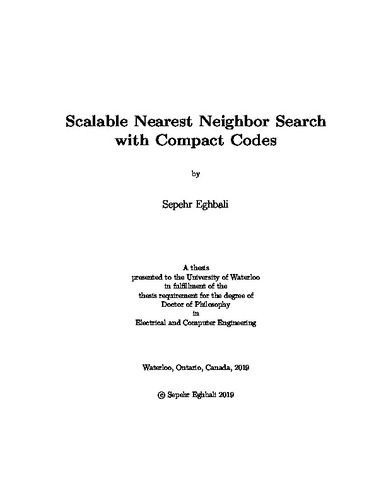| dc.contributor.author | Eghbali, Sepehr | |
| dc.date.accessioned | 2019-12-19 21:27:17 (GMT) | |
| dc.date.available | 2019-12-19 21:27:17 (GMT) | |
| dc.date.issued | 2019-12-19 | |
| dc.date.submitted | 2019-11-25 | |
| dc.identifier.uri | http://hdl.handle.net/10012/15355 | |
| dc.description.abstract | An important characteristic of the recent decade is the dramatic growth in the use and generation of data. From collections of images, documents and videos, to genetic data, and to network traffic statistics, modern technologies and cheap storage have made it possible to accumulate huge datasets. But how can we effectively
use all this data? The growing sizes of the modern datasets make it crucial to develop new algorithms and tools capable of sifting through this data efficiently. A central computational primitive for analyzing large datasets is the Nearest Neighbor Search problem in which the goal is to preprocess a set of objects, so that later, given a query object, one can find the data object closest to the query. In most situations involving high-dimensional objects, the exhaustive search which compares the query with every item in the dataset has a prohibitive cost both for runtime and memory space. This thesis focuses on the design of algorithms and tools for fast and cost efficient nearest neighbor search. The proposed techniques advocate the use of compressed and discrete codes for representing the neighborhood structure of data in a compact way. Transforming high-dimensional items, such as raw images, into similarity-preserving compact codes has both computational and storage advantages as compact codes can be stored efficiently using only a few bits per data item, and more importantly they can be compared extremely fast using bit-wise or look-up table operators. Motivated by this view, the present work explores two main research directions: 1) finding mappings that better preserve the given notion of similarity while keeping the codes as compressed as possible, and 2) building efficient data structures that support non-exhaustive search among the compact codes. Our large-scale experimental results reported on various benchmarks including datasets upto one billion items, show boost in retrieval performance in comparison to the state-of-the-art. | en |
| dc.language.iso | en | en |
| dc.publisher | University of Waterloo | en |
| dc.subject | machine learning | en |
| dc.subject | computer vision | en |
| dc.subject | information retrieval | en |
| dc.subject | nearest neighbor search | en |
| dc.subject | compression | en |
| dc.title | Scalable Nearest Neighbor Search with Compact Codes | en |
| dc.type | Doctoral Thesis | en |
| dc.pending | false | |
| uws-etd.degree.department | Electrical and Computer Engineering | en |
| uws-etd.degree.discipline | Electrical and Computer Engineering | en |
| uws-etd.degree.grantor | University of Waterloo | en |
| uws-etd.degree | Doctor of Philosophy | en |
| uws.contributor.advisor | Tahvildari, Ladan | |
| uws.contributor.affiliation1 | Faculty of Engineering | en |
| uws.published.city | Waterloo | en |
| uws.published.country | Canada | en |
| uws.published.province | Ontario | en |
| uws.typeOfResource | Text | en |
| uws.peerReviewStatus | Unreviewed | en |
| uws.scholarLevel | Graduate | en |

